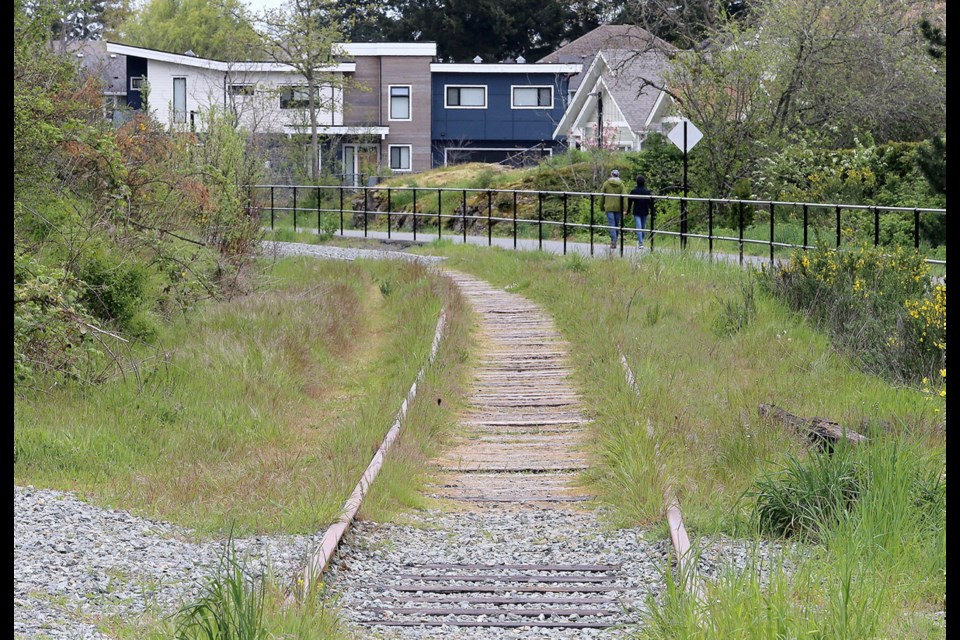A “Cadillac” version of a potential commuter-rail service between Langford and Victoria is not needed right now, says the chief executive of the Island Corridor Foundation.
Larry Stevenson was reacting to the estimated $595-million price tag for a commuter service, cited in a consultant’s report that looked at the condition of the old E&N line, as well as options and costs for passenger and freight service.
The construction cost alone to upgrade the Langford-to-Victoria stretch is about $28 million, Stevenson said. The balance of the $595 million would include new rail cars, stations, signal upgrades, a maintenance facility and property purchases.
Stevenson envisions a more modest commuter-rail service.
“I don’t think anybody is going to say that we should spend $600 million to build a Cadillac commuter service between Langford and Victoria, given today’s environment and given the population of the Island,” Stevenson said.
“But 20 years from now, you may want to do that.”
Stevenson praised the report, released this week, from WSP saπ˙º ¥´√Ω Group Ltd. The report was commissioned by the province and will be used as saπ˙º ¥´√Ω develops a South Island transportation strategy.
The Island Corridor Foundation, led by Island regional districts and First Nations, owns the 289-kilometre-long rail corridor running between Victoria and Courtenay, with a leg between Nanaimo and Port Alberni. Passenger service shut down in 2011 over concerns about the condition of the tracks. Now only a short freight line runs near Nanaimo
Stevenson, who is still examining the 108-page document, said he’s happy with the report overall. “It did what I had asked them to do,” he said.
“I had asked them … let’s get down to kicking rocks. Let’s get down to understanding what the basic costs are to fix the track. They’ve done that.”
He agrees with the report’s evaluation of the condition of the track and of the bridges, which would require upgrading.
The report outlines three levels of service along the main line, with costs ranging from $326 million to $729 million. It breaks expenses into geographical segments on the line and cites costs for each level of service.
Stevenson is keen to speak to the consultant about some of the details, noting there are possibilities for savings. For example, the portion of the line between Nanaimo and Port Alberni would need to be able to carry the maximum weight loads for freight, whereas that capacity would likely not be needed from Nanaimo south. That could make a difference of $100 million.
As an advocate for rail service that he believed would cost in the $30-million range, Langford Mayor Stew Young said he was discouraged to see the
$500-million-plus figure.
“The only way to solve it really is to get it out to the private sector, put it out there for a request for proposals and really see what it does actually cost.”
Young is unhappy that taxpayers have had to pay for work such as signal-lights maintenance in recent years even though no service is being provided, and said allowing the track to sit idle has only increased costs as it has aged.
“At one point, you just have to stop, you know what I mean? And shut down the Corridor Foundation. Give the corridor back to the provincial or federal government and tell them to manage it as a corridor.”
That could mean rail or another use, he said.
“You still have to preserve the corridor and you still have to make sure that people have that opportunity to weigh in on it. I’m sure the public will weigh in on this thing and have their own opinions of it.”
Stevenson dismissed Young’s suggestion of the foundation relinquishing ownership of the corridor, saying it will not be handed over.
Victoria Mayor Lisa Helps, who sits on the saπ˙º ¥´√Ω Transit board and on the board of the Victoria Regional Transit Commission, would like the province to conduct an in-depth analysis that looks at return on investment for rail, including factors such as how many cars it would get off the road, reduction in wear and tear on road infrastructure and impact on greenhouse gases.
“Those are the questions that
I would be asking if I were the province before deciding to invest half a billion dollars or more, depending on which number you look at,” Helps said.
She said the province should do a cost-benefit analysis of the Langford-to-Victoria route, looking at how many people can be moved for what cost per kilometre by rapid bus versus by train.
Helps said rapid buses have proven to have greater benefits than commuter rail in many cases in cities around the world, adding the introduction of rapid-transit bus lanes in Victoria resulted in significant ridership increases.
“The idea is to move people quickly and efficiently and affordably and in a low-carbon way. That’s the whole point of a train or a bus.”



